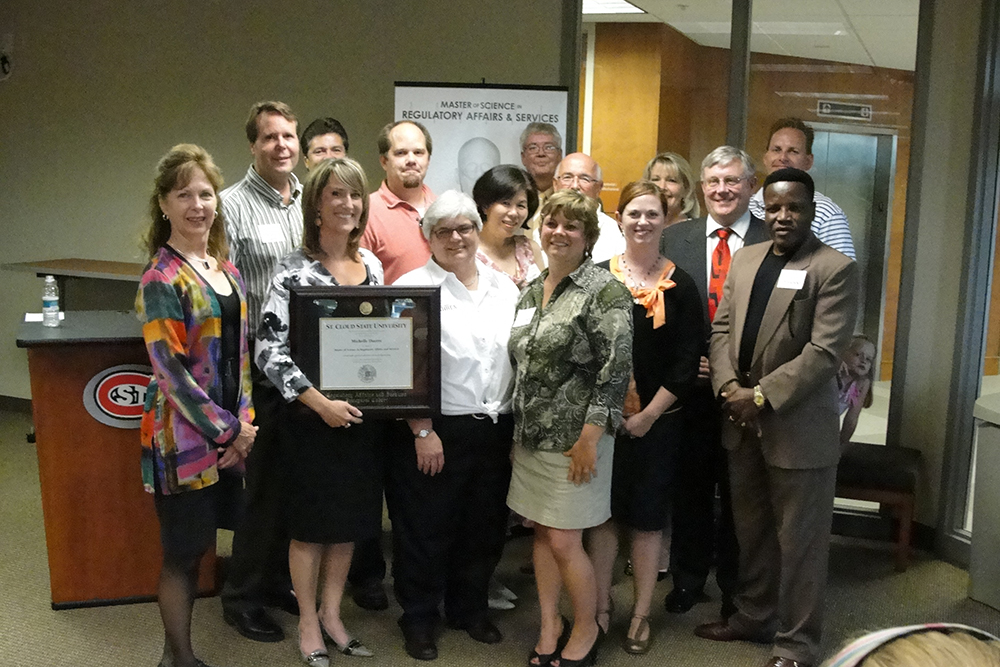The first graduating RAS class
The first graduating class in the regulatory affairs and services program completes the program in 2009. Front Row: Cindy Zehrer, left, Micki Duerre, Cathy Schenk, Wendy Pinor, Heather Taylor and Kingsley Furo. Back row: Mark Lanz, left, Brian Rembish, Tom Rademacher, Susanne Kennedy, David DeGroote, Chuck Swanson, Cathy (Japs) Reichenbacher, President Earl H. Potter and Waylon Vanderpoel.
With 195 alumni in the field, three active master’s programs and four graduate certificates, St. Cloud State University’s medical technology (MedTech) graduate education is continuing to grow 10 years after the first regulatory affairs and services students sat down for classes.
St. Cloud State launched the regulatory affairs and services graduate program in 2007 to help meet the Minnesota medical device industry need for people skilled in medical device regulation.
“Our graduates support Minnesota companies,” said Cathy Krier, regulatory affairs and services program director. “The St. Cloud State MedTech programs are providing talent needed by the medical device industry at a time when evidence-based regulations are more prevalent with the growing complexity of medical technology.

A needed program
The idea for the program was sparked by Brian Rembish, a 2005 MedTech industry consultant for the Science Initiative of Central Minnesota, who pointed out that regulatory affairs in the medical device industry was an area that could use more attention.
David DeGroote, then dean of the College of Science and Engineering at St. Cloud State, heard Rembish speak and researched the issue finding no regulatory program in the United States that focused specifically on medical devices, according to a 2007 article for the Regulatory Affairs Professional Society by DeGroote and Rembish.
St. Cloud State University then consulted with regulatory experts in the medical device industry to develop curriculum.
 “The depth and breadth of classes, plus the real-world experiences of the instructors … form a solid foundation to understanding regulatory science for medical devices.”
“The depth and breadth of classes, plus the real-world experiences of the instructors … form a solid foundation to understanding regulatory science for medical devices.”]The regulatory affairs and services program was approved by the university in 2006 and then by Minnesota State Colleges and Universities (Minnesota State) system in 2007.
Cathy Schenk ’09 came into the program for the first cohort as someone already working as a quality director with a background in device and biologics. She was looking for a deeper understanding of the regulatory side of the business and found it in the program.
“Although I have stayed in the quality field, the program gave me a very valuable background and understanding of regulatory that has certainly helped in my career,” she said. “The degree has afforded me the opportunity to make more money, and, more importantly, to seek and find positions that would not otherwise have been open to me.”
The first students began that fall with courses held evenings and weekends at North Hennepin Community College in Brooklyn Park — where the students were studying near the facilities of many of the state’s medical device companies.
The program featured 10 courses and a culminating project.
In that first cohort was Heather Taylor ’09 who bonded with her classmates through the two years of the program.
“It was hectic — four hour classes several times a week on top of working full time — plus homework and group assignments. However, it was also interesting and challenging,” she said. “… It was a great opportunity. I met with people from across the industry and learned about a field that I wasn’t well acquainted with.”
Taylor now works in regulatory affairs for Medtronic.
“I used my knowledge about regulatory affairs to apply for a position with the regulatory team while still attending the RAS program, and it certainly helped me get that job,” she said.
In addition to drawing on industry expertise for curriculum, the program also used medical device experts in the classroom. Several faculty members have extensive background in the region’s medical device industry.
Nancy Cameron ’10 drew on that expertise when she entered the program with a background in pharmaceutical laboratory.
“The depth and breadth of classes, plus the real-world experiences of the instructors in the St. Cloud State regulatory affairs and services master’s program form a solid foundation to understanding regulatory science for medical devices,” she said. “This program helped me smoothly transition my career … into a regulatory position in the medical device industry.”

Expanding to new disciplines
The university expanded its medical technology programs to include master’s programs in applied clinical research in 2010 and medical technology quality in 2012 as the university opened its Twin Cities Graduate Center in Maple Grove to expand with more graduate program offerings in the region.
The university’s MedTech offerings expanded again in 2015 with the launch of graduate certificates in applied clinical research, regulatory affairs and services, medical technology quality and general medical device regulation.
All three programs are now available at St. Cloud State at Plymouth as either part-time or full-time programs and can be attended remotely through a synchronous online connection.
The online flexibility is already helping students advance their careers.
Dan Griggs’ 13 was able to relocate for a new job out of state because he was able to complete his program through remote-learning. During his last semester he re-located to San Francisco to work for the British Standards Institute.
“I was able to join my fellow students and actively participate in lectures and activities via Adobe Connect — completing my program, without interruption and on time,” he said. “… This program, together with my business experience, vaulted me into an entirely new industry.”
Since the regulatory affairs and services program launched in 2007, the MedTech education programs have served 400 students — 90 percent of whom have completed or are continuing toward their graduate degree or certificate.
“The graduates from these programs support Minnesota’s medical device industry growth and innovation,” Krier said.

